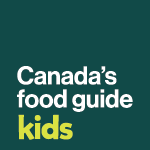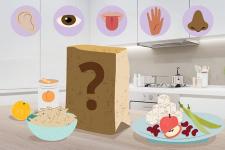Summary
Children will explore foods that are part of Canada’s food guide using their five senses. Using their senses of smell and touch, they will guess foods that are hidden in a box. They will also have the choice to try bite-sized samples of foods.
Prep time
60 minutes
Activity duration
40 minutes
On this page
- Learning goals
- Materials
- Planning considerations
- Connecting to Canada’s food guide
- Activity instructions
- Optional learning extension
Learning goals
- Identify various foods
- Describe foods using the five senses
Materials
- Paper bags
- Bowls, one per child
- Plastic or glass container
- Spoons or forks, one per child
- Variety of foods to touch, for example:
- soft or firm tofu
- dry or canned beans, lentils, split peas
- dry or cooked brown rice, quinoa, or oats
- fresh, frozen or canned vegetables and fruits
- Variety of foods to taste. For example, prepare bite-sized:
- tofu
- kiwis
- apples
- bananas
- bean dip
- brown rice
- pineapples
- thawed berries
- sweet potatoes
- whole wheat pasta
- carrots, cut into matchsticks
- cheese cubes, lower fat, lower sodium
- canned peaches, unsweetened, packaged in water
Planning considerations
- Consider how much time you would like your group to spend on this activity. Part 1 and Part 2 can be completed on the same day or divided into 2 sessions.
- Wash your hands and read through food safety considerations before handling or preparing food.
- Gather materials, such as paper bags, bowls, containers, and more.
- Obtain and cut up a variety of vegetables and fruits, whole grain foods and protein foods.
- Foods can be fresh, frozen and thawed, or canned and drained.
- Connect with parents or guardians to identify any concerns about food allergies or dietary restrictions.
Connecting to Canada’s food guide
- Review the following pages to better understand Canada’s food guide and inspire your activity planning:
Activity instructions
Engage
- Discuss the five senses and what body part is responsible for each sense, for example:
- eyes are used to see
- ears are used to hear
- noses are used to smell
- mouths are used to taste
- hands and skin are used to touch
- Explain that we use all our available senses when we eat. Not everyone has all five senses, so some people use certain senses more than others. Our senses can influence our food likes and dislikes.
- Discuss which foods the children associate with different senses. You can do this by asking:
- What foods have you tried that taste:
- sour?
- salty?
- spicy?
- sweet?
- What foods have you tried that feel:
- soft?
- hard?
- spongy?
- crumbly?
- What foods have you tried that are:
- red?
- blue?
- green?
- round?
- What foods have you tried that:
- smell sweet?
- smell very strong?
- don’t smell much?
- What foods have you tried that sound crunchy?
- What foods have you tried that taste:
- Be mindful that children have varying access to food. We encourage you to think about how sensitive this topic may be and to address it with care and compassion.
Explore
Part 1 – Guess what's in the box!
- Ask children to wash their hands before starting the activity.
- Pick a food item and place it in a container. This can include vegetables and fruits, whole grain foods or protein foods.
- Place the container in a large paper bag. Ask children to put their hand in the bag and feel the item.
- Ask children to guess what food they think is in the bag. Invite them to touch the food and use their senses to inform their guess.
- Place different foods in the container within the bag and repeat the activity.
- Review and follow food safety considerations throughout the activity.
- Have a few foods cut into bite-sized pieces.
- Have children wash their hands and their workspace. Ask them to select some foods that they would like to explore.
- Remember that it is important to create a supportive environment for children to become familiar with new foods. Aim to create a judgment-free space for them to explore new items, without pressure to eat them.
- Ask the children to look, touch, smell, and taste the different foods, if they want.
- Ask children how these different foods can be eaten. For example:
- Kiwis can be cut in half and eaten with a spoon.
- Oranges can be peeled and eaten with our hands.
- Carrots and celery can be cut into sticks and eaten with our hands.
- Ask children how did the foods look before they were prepared and after they were prepared? For example:
- Pineapple is big, brown, and prickly before it is prepared. It is smooth, yellow, and small after it is prepared.
- If a child decides that they do not wish to eat the foods, you can invite them to politely decline by saying “No, thank you.”
Tip: If your facility has access to cooking equipment, you can provide foods at different temperatures for children to explore. For example:
- Carrots and apples are hard when raw, soft and creamy when cooked.
Explain
- As a group, ask children to share their experiences with the different foods. Ask them:
- How did they smell?
- How did they feel when you touched them?
- What did they look like? For example:
- size
- shape
- colour
- What did you taste when you placed them on your tongue? Did you like or dislike them?
- What did you hear as you ate the foods?
Optional learning extension
Have children take turns to think of a food that they explored in Part 1 of the activity. Ask them to provide clues to the group about different characteristics of that food. For example, the food item is:
- red
- round
- smooth
Each child can take turns getting the other children to guess the food item.



